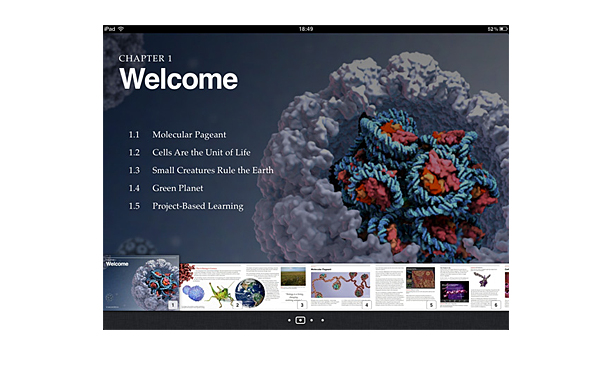 The Apple company has introduced three educational services in New York. Together, they give the iPad a huge potential as a learning platform.
The Apple company has introduced three educational services in New York. Together, they give the iPad a huge potential as a learning platform.
Yesterday, Apple, as promised, held a presentation on education. There were no high-profile releases. Representatives of the company in a quiet, lulling manner demonstrated a number of projects that Steve Jobs, who cherished the dream of changing education with the help of the latest technologies, apparently conceived to implement.
iBooks 2 is the main project presented at the presentation. The updated service is now able to work with multimedia books, including textbooks, in the iPad version, which, in fact, was the focus of the presentation.

The textbooks presented by the company seem to have come out of science fiction novels: the text is adjacent to interactive pictures, video and sound files, bright diagrams and three-dimensional models. In fact, Apple has finally introduced what the iPad was created for.
So far, there are only 8 such textbooks in iTunes. Including biology, chemistry, physics, algebra and geometry. The price of each of them is $ 15. However, there is also a free textbook “Life on Earth” by O.E. Wilson. However, only American users of the service can download it or buy any other.
The weight of books, on average, reaches several gigabytes.
Along with the release of iBook 2, which took place simultaneously with the presentation, the company showed the iBooks Author application for the Mac App Store, which allows you to create multimedia books. The application is absolutely free, moreover, anyone who has collected his own Talmud on his knee can post his work in the iBook store at a price of $ 15 and below. In return, the company will take 30% of sales.

Here, however, there is a small nuance. Apple requires exclusive publishing rights if you sell a book on iTunes. In the case of free placement on it, you are free to publish your book outside the service wherever and however you want.
Creating a book in iBooks Author, according to the company’s representatives, is extremely simple. Images and videos can be inserted by simply dragging and dropping even from Word documents. It is assumed that with the help of this tool, teachers will immediately start creating high-quality and interesting teaching materials.

The third release from Apple also concerned education. The fact is that the company reconstructed iTunes U, a service where you could listen and watch lectures by famous professors from almost any more or less large university in the world.
Now iTunes U is not only a service, but an application that allows students or those who are just interested to fully study a particular course. It is assumed that teachers will post not only recordings of their lectures, but also curricula, which, in fact, are ordered collections of links to various resources (including lectures, books, scientific articles).

In general, despite the fact that there has not been a revolution (the announcement of the iPad 3 is still ahead), it is safe to say that Apple has set about harnessing the potential that has not yet been revealed by tablet applications. In other words, the company is still a leader in innovation, which is good news.
